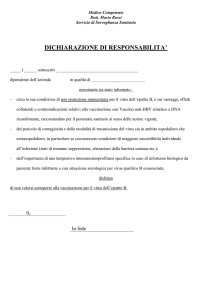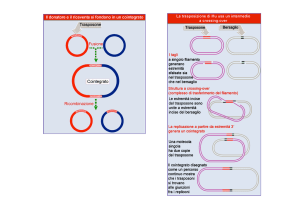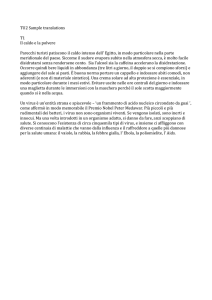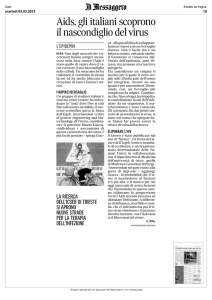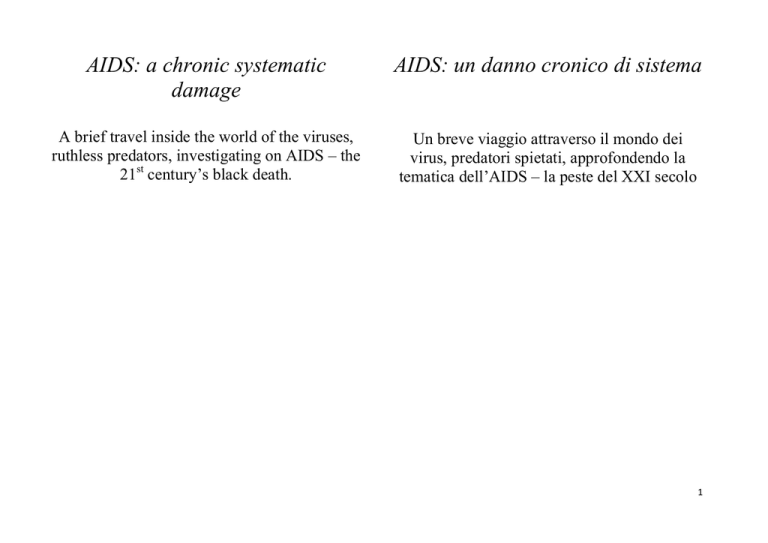
AIDS: a chronic systematic
damage
AIDS: un danno cronico di sistema
A brief travel inside the world of the viruses,
ruthless predators, investigating on AIDS – the
21st century’s black death.
Un breve viaggio attraverso il mondo dei
virus, predatori spietati, approfondendo la
tematica dell’AIDS – la peste del XXI secolo
1
VIRUSES
VIRUS
What are viruses?
Cosa sono i virus?
Viruses are intracellular obliged parasites,
i.e. they need to infect a living cell to
replicate. Viruses do not have any structure
to replicate, they are very little and simple
and this is why they are regarded as nonliving creatures. The cell they infect dies
due to lack of energy and resources (ATP
and proteins), stress collapse or is destroyed
by the virus itself.
I virus sono parassiti intracellulari obbligati, cioè hanno bisogno di
una cellula vivente per duplicarsi. I virus non hanno alcuna struttura
riproduttiva, sono molto piccoli e semplici, per questo sono
considerati esseri non viventi. La cellula che infettano per replicarsi
muore per l’esaurimento di energia e risorse (ATP e proteine), per
collasso da stress o viene distrutta dal virus stesso.
The first virus to be identified, in 1898, was the one which causes a
disease called “mosaic” in tobacco plants, or
TMV (Tobacco Mosaic Virus). The Dutch
biologist Beijerink noticed that the pathogen he
isolated was too small to be a bacterium but too
big to be a toxin, so he called it “virus”. The
word “virus” comes from Latin and means
“poison”.
Il primo virus ad essere
identificato, nel 1898, è stato il
virus che causa la malattia del
mosaico nelle piante di tabacco,
o TMV (Tobacco Mosaic
Virus). Il biologo olandese
Beijerink notò che l’agente
patogeno che aveva isolato era
troppo piccolo per essere un batterio ma troppo grande per essere una
tossina, così lo chiamò “virus”. La parola “virus” viene dal latino e
significa “veleno”.
Over 5,000 viral species are known so far, but
scientists believe that there are a thousand times more: they live in
every habitat in the biosphere, everywhere there are organisms to
infect.
Fino ad oggi sono conosciuti più di 5000 specie virali, ma gli studiosi
ritengono che ce ne sia un numero mille volte più grande: essi vivono
in ogni habitat della biosfera, ovunque ci siano organismi da
parassitare.
.
2
The structure of a virus
La struttura di un virus
Virus alternate two different phases: at first they look like dead “genes
containers”; but as they enter the cell, they interosculate with it, losing
their individuality and starting a berserk biologic activity. When a
virus is outside the cell, it is called “virion”.
I virus alternano due fasi: in un primo momento essi si presentano
come “contenitori di geni” morti, senza alcuna vitalità; nel momento
in cui entrano nella cellula, però, si confondono con essa, perdendo la
loro individualità e iniziando una frenetica attività biologica. Quando
un virus si trova al di fuori della cellula prende il nome di “virione”.
Virions can have a wide variety of shapes, even very fancy, but
roughly they consist of a ribonucleic acid (DNA or RNA), inside a
shell called “capsid”, made of one repeated protein. Some viruses
have a lipoproteic or glicoproteic membrane around the capsid called
envelope. The envelope is a piece of the cellular membrane taken off
by newborn virions as they go out of the cell. This gives viruses their
high specificity (they have species-specificity, one virus infects only
one or at least two species, and tissue-specificity, i.e. they infect a
specific type of organ or tissue) and works like a “disguise”: many
virus can enter the cell without being “intercepted” immediately tanks
to it indeed. The envelope is fixed to the capsid by membrane
proteins, and between them there is a solutions that protects the
structure from bumps and isolate it from temperature variations.
I virioni presentano una grande varietà di forme, anche molto
fantasiose, ma approssimativamente sono tutti composti da un acido
ribonucleico (DNA o RNA), contenuto in un involucro chiamato
“capside”, fatto da una sola proteina che si ripete. Alcuni virus hanno
una membrana lipoproteica o glicoproteica che avvolge il capside e
che pertanto prende il nome di “pericapside”. Il pericapside è una
parte della membrana della cellula che viene strappato via dai virioni
appena formati al momento della fuoriuscita. Questo conferisce ai
virus la loro altissima specificità (sono specie-specifici , selettivi in
base alla specie, e tessuto-specifici, infettano solo determinati organi e
tessuti) e funge da “travestimento”: grazie ad esso, infatti, molti virus
riescono a penetrare nelle cellule senza essere “intercettati”
immediatamente. Il pericapside è fissato al capside da delle proteine
di membrana, e tra di essi è presente un liquido che protegge dagli urti
e isola termicamente la struttura.
3
4
Two ways of replicating
Due modi per replicarsi
A virus can enter the cell in two different ways: either injecting its
DNA or RNA inside the cell like a syringe (bacteriophages) or by
endocytosis. When it is captured by a bubble the virus can be released
into the cell or activate a ruthless process: once in the bubble, it is
identified as a foreign body, so a lysosome activates; however, as the
lytic enzymes are about to take action, the virus releases “counterenzymes” which inactivate the ones of the cell and dissolve the
bubble, so that the pathogen move through the cytoplasm.
Il virus può entrare nella cellula in due modi diversi: o iniettando il
suo materiale genetico nella cellula come una siringa (batteriofagi o
fagi) o per endocitosi. Quando viene inglobato nella vescicola il virus
può essere liberato nella cellula o può mettere in atto un meccanismo
che definiremmo “perverso”: una volta inglobato nella vescicola, esso
viene riconosciuto come un agente estraneo e quindi un lisosoma si
prepara ad entrare in azione; tuttavia, appena gli enzimi litici
cominciano a digerire il primo strato del pericapside o del capside, si
liberano dei “contro-enzimi” che inattivano quelli della cellula e
addirittura sciolgono la membrana vescicolare e si liberano nel
citoplasma.
Once inside the cell, viral genome can take two different courses: it
either can replicate immediately or it can insert into cellular DNA and
keep quiescent as a “provirus”. The provirus replicates as the cell
enters meiosis and it can be activated by stress, chemicals or
radiations. When the virus is activated, it tears away from the
chromosome and starts replicating through the viral mechanism.
The first process is called lytic cycle, the second one is the lysogenic
cycle.
A weird fact is that in human DNA there are lots of inactive viral
genes that cannot activate anymore. Once they may have caused
mutations (which are the “vehicle of evolution”) or may have been the
responsible of terrible diseases, but now they are harmless.
Una volta entrato nella cellula, il genoma virale può seguire due
percorsi differenti: può replicarsi immediatamente prendendo il
controllo della cellula o può inserirsi nel DNA cellulare e rimanere
quiescente (“a riposo”) trasformandosi in pro virus e replicandosi
insieme alla cellula stessa, fino a quando non sarà attivato da stress,
sostanze chimiche o radiazioni e si staccherà dal cromosoma cellulare
per replicarsi (excisione). Il primo processo si chiama ciclo litico,
mentre il secondo è definito ciclo lisogeno.
È impressionante sapere che nel DNA umano ci sono molti geni virali
che non possono più essere attivati. Un tempo essi potrebbero aver
causato mutazioni (che sono il “veicolo dell’evoluzione”) o
potrebbero essere stati responsabili di malattie pericolose, ma adesso
sono innocui.
5
6
DNA and RNA viruses
Virus a DNA e ad RNA
The Baltimore classification divides viruses into seven different
classes:
La classificazione di Baltimore suddivide i virus in sette classi
differenti:
1234567-
dsDNA viruses (double stranded DNA)
ssDNA viruses (single stranded DNA)
dsRNA viruses (double stranded RNA)
ssRNA + viruses (positive single stranded RNA)
ssRNA – viruses (negative single stranded RNA)
ssRNA retroviruses
dsDNA retroviruses (this group is often omitted and included
in the first one)
The life of a normal cell is regulated by the DNA-RNA-protein
succession, the so called “central dogma of molecular biology” (but
today it is not a dogma anymore, it is just a catchphrase as Francis
Crick stated). When retroviruses infect cells, they synthesize DNA
from their little quantity of RNA through an enzyme called “inverse
transcriptase” and inserts it into cellular DNA. They are called
“retrovirus” due to this “reverse” process.
1234567-
Virus a dsDNA (DNA a filamento doppio)
Virus a ssDNA (DNA a filamento singolo)
Virus a ds RNA (RNA a filamento doppio)
Virus a ssRNA + (RNA a filamento singolo positivo)
Virus a ssRNA – (RNA a filamento singolo negativo)
Retrovirus a ssRNA (RNA a filamento singolo)
Retrovirus a dsDNA (DNA parziale a filamento doppio;
questo gruppo tuttavia è spesso omesso e compreso nel primo).
La vita di una cellula normale è determinata dalla catena DNA-RNAproteina, il cosiddetto “dogma centrale della biologia” (che oggi di
dogma non ha più niente, ma è solo una “frase ad effetto” come ha
affermato Francis Crick). Quando un retrovirus infetta una cellula,
produce DNA dalla sua piccola quantità di RNA attraverso un enzima
chiamato “trascrittasi inversa” e lo inserisce nel DNA della cellula.
Proprio a causa di questo processo “a ritroso”, questi virus sono detti
“retrovirus”.
7
Some interesting viral diseases
•
Herpesviridae – the
members of this group
are known because
they lie dormant after
the first infection
(most of them in the
trigeminal nerve) and
can activate even
several years due to stress, temperature variations, radiations
and illnesses which may disturb the immune system (even a
fever). The most known members are from the first group, the
so called “α-Herpesviridae”. They cause lips and genital
herpes (HHV-1 and HHV-2) and varicella (HHV-3). The
second infection of HHV-3 leads to herpes zoster, better
known as “shingles”, and that is why this virus is also called
VZV (Varicella-Zoster Virus).
Alcune malattie interessanti causate dai virus
•
Herpesviridae – i componenti di questo gruppo hanno la
caratteristica di rimanere latenti dopo la prima infezione (per
lo più nel nervo trigemino) e possono attivarsi anche dopo
diversi anni a causa di stress, variazioni di temperatura,
radiazioni e malattie che possono causare scombussolamenti
nel sistema immunitario (anche una febbre). I membri più
conosciuti appartengono al primo gruppo, quello dei cosiddetti
“α-Herpesviridae”. Essi causano l’herpes labiale e genitale
(HHV-1 e HHV-2) e la varicella (HHV-3). Il riattivarsi
dell’HHV-3 provoca l’herpes zoster, conosciuto meglio come
“fuoco di
sant’Antonio”, ed
è per questo
motivo che tale
virus si chiama
anche VZV
(Varicella-Zoster
Virus).
8
•
Ortomyxoviridae – it is a big viral family whose members
cause influenza. The majority of influenza viruses is carried by
birds and infects pigs and humans. That is why the virus is
unstable: while it is carried, it modifies two membrane
proteins – the HA protein (hemoagglutinine) and the NA
(neuraminidase) – which give the name to the influenza
(H1N1, H5N1, H3N8…). New influenza virus are born and
other disappear every year, and that is the reason why vaccines
work only in the 87% of the cases. Vaccines are “cocktails” of
different kinds of influenza viruses from the previous years,
which are inactivated or weakened, grown in sterilised chicken
eggs or built in laboratory.
•
Ortomyxoviridae – è una grande famiglia virale i cui membri
causano l’influenza. La maggior parte dei virus influenzali
utilizza come veicolo gli uccelli e infetta maiali e uomini.
Proprio per questo motivo il virus dell’influenza è mutevole:
durante il “trasporto”, esso modifica due proteine di membrana
– la proteina HA (emoagglutinina) e la proteina NA
(neuraminidasi) – che danno il nome all’influenza (H1N1,
H5N1, H3N8…). Ogni anno nascono nuovi tipi di virus
influenzali e se ne estinguono altri, ragion per cui i vaccini
influenzali funzionano solo nell’87% dei casi. I vaccini infatti
rappresentano un “cocktail” di ceppi virali degli anni
precedenti, inattivati o indeboliti, coltivati in uova di gallina
sterilizzate o assemblati in laboratorio.
9
•
Flaviviridae – the majority of viruses causing hemorrhagic
fevers like yellow fever and dengue belong to this group.
These diseases are common in tropical areas because they
spread through ticks and mosquitos. In these cases the diseases
are not caused by the virus itself but it is a sort of lethal
“misunderstanding”: an individual suffers only high fever and
pain the first time he/she is infected by a dengue virus, e.g.
DEN-1, but these symptoms are not deadly. At the second
infection the situation is very dangerous though: there is a
wide range of dengue virus, with some
similarities but lots of differences – so it
is almost impossible to be infected twice
by the same virus. Once in the body, the
new virus – for example DEN-2, is
attacked by antibodies. They do not
eliminate the virus though, but just stick
to it, allowing the pathogen to reach
every cell of the body through the
immune system with devastating
consequences.
•
Flaviviridae - a questo gruppo appartiene la maggior parte dei
virus che causano le febbri emorragiche, come la febbre gialla
e la dengue. Queste malattie sono comuni nelle zone tropicali
perché utilizzano come vettori zecche e le zanzare. In questo
caso i sintomi non sono causati dal virus in sé, ma si tratta di
un “malinteso” che risulta letale: la prima volta che un
individuo viene infettato da un virus dengue, che chiamiamo
per esempio DEN-1, presenta soltanto febbre alta e dolori ,
sintomi in ogni caso non mortali. La seconda volta che un
individuo è infettato la situazione diventa molto
pericolosa: esiste una grandissima varietà di
virus dengue che presentano qualche analogia
ma moltissime differenze – quindi è
difficilissimo in termini statistici essere colpiti
due volte dallo stesso virus. Una volta penetrato
nell’organismo, il nuovo virus – per esempio
DEN-2 – è attaccato dagli anticorpi. Tuttavia
essi non distruggono il patogeno, ma
semplicemente si attaccano ad esso,
consentendogli di raggiungere tutte le cellule
del corpo attraverso il sistema immunitario, con effetti
devastanti.
10
AIDS: A NEW PLAGUE
AIDS is often regarded as the 20th century black death, because it
reminds of the plague epidemic which spread across Asia and Europe
between 1347 and 1351. Plague is the stereotype of a destroying
epidemic, but today AIDS is even more frightening: differently from
plague or common cold, AIDS may lie dormant for years before
causing the first symptoms and in this way the number of cases and
the death toll will continue rising for years, especially in poorer
nations.
The name
AIDS means “Acquired Immune Deficiency Syndrome”. This is one
of the most complicated names in the history of medicine and means
that the disease is characterized by several clinically recognizable
features, signs and symptoms that occur together (“Syndrome”), all of
which come from a weakening of the immune system (“Immune
Deficiency”) caused by a transmittable pathogen (“Acquired”).
AIDS: UNA NUOVA PESTILENZA
L’AIDS è spesso considerato la “morte nera” del XX secolo, perché
richiama alla mente l’epidemia di peste che si diffuse dall’Asia
all’Europa tra il 1347 e il 1351. La peste è lo stereotipo dell’epidemia
distruttrice, ma oggi l’AIDS è ancora più spaventoso: a differenza
della peste o del raffreddore comune, l’AIDS può rimanere quiescente
per anni prima di causare i primi sintomi e per questo motivo i casi e
il tasso di mortalità continueranno a salire, specialmente nei Paesi più
poveri.
Il nome
AIDS significa “Sindrome dell’Immunodeficienza Acquisita”. Questo
nome è tra i più complicati della storia della medicina e significa che
la malattia è caratterizzata da una serie di condizioni, manifestazioni e
sintomi che concorrono (“Sindrome”), tutti provenienti da un
indebolimento del sistema immunitario (“Immunodeficienza”) causato
da un patogeno trasmissibile (“Acquisita”).
11
The discovery
La scoperta
HIV (Human Immunodeficiency Virus) was discovered independently
in 1983 by Luc Montaignier in Paris and by Robert Gallo in the USA.
This double-discovery caused a dispute on who was worth the Nobel
prize. Eventually Montaigner received it and Gallo is regarded as the
co-discover, although he and his team developed scientific methods
that made the discovery possible. HIV is a mutation of the SIVcpz
(Simian Immunodeficiency Virus of chimpanzee). However the
moment when the virus passed from
monkeys to humans is not clearly
known: it is thought it happened
between the end of the 19th century
and the early 20th in Africa due to the
contact with infected blood during
chimpanzee hunting or because of the
habit of eating chimpanzee raw meat.
The first certain case dates back to a
blood sample taken from an African
man in 1959 and analysed in the
1980s, while it is believed that it has
spread in the USA in the 1960s during the so called “sexual
revolution”.
L’HIV (Virus dell’Immunodeficienza Umana) fu scoperto
indipendentemente nel 1983 da Luc Montaignier a Parigi e da Robert
Gallo negli Stati Uniti. La doppia scoperta causò una disputa su chi
avrebbe meritato il premio Nobel. Alla fine lo ricevette Montaigner e
Gallo viene considerato il co-scopritore, sebbene lui e il suo team
abbiano sviluppato i metodi scientifici che hanno reso possibile la
scoperta. L’HIV è una mutazione del SIVcpz (Virus
dell’Immunodeficienza delle Scimmie, specie scimpanzé). Tuttavia
non si sa con esattezza quando
avvenne il passaggio del virus dalle
scimmie all’uomo: si pensa tra la fine
dell’Ottocento e i primi decenni del
XX secolo in Africa a causa del
contatto con sangue infetto durante le
battute di caccia agli scimpanzé o in
seguito all’usanza di cibarsi delle
carni crude di questi animali. Il primo
caso accertato risale ad un campione
di sangue prelevato da un uomo in
Africa nel 1959 e analizzato negli anni Ottanta, mentre si ritiene che
sia stato diffuso negli Stati Uniti negli anni Sessanta durante la
cosiddetta “rivoluzione sessuale”.
12
Breaking down the walls
Abbattendo le mura
Many microorganisms are harmless for a normal person – we get in
touch with billions of bacteria, viruses and toxins without damages
indeed – but are lethal for HIV-positives: the virus damages the
immune barrier allowing the so called “opportunistic infections” to hit
every part of the body. They can be common diseases but also rare
cancers, like Kaposi’s Sarcoma.
La maggior parte dei microorganismi sono innocui per un individuo
normale - basti pensare che ogni giorno noi entriamo in contatto con
miliardi di batteri, virus e tossine senza riportare danni - ma risultano
mortali per chi è HIV-positivo: il virus danneggia la barriera
immunitaria permettendo alle cosiddette “infezioni opportunistiche”
di colpire ogni parte del corpo. Esse possono essere malattie comuni
ma anche tumori rari, come il Sarcoma di Kaposi.
The immune system attacks the virus as it enters the body, so the
patient just suffers “soft” symptoms like a normal fever. The virus is
not defeated though, but continues replicate faster and faster. Many of
the newborn viruses are destroyed, but many other infect every cell of
the body having a “CD4” membrane protein, i.e. helper-T cells of the
immune system (the “generals” among the cells of the immune
system, which “give directions” to the other cells – killer T, B
lymphocytes and antibodies – what and how to attack). When the
virus is in the cytoplasm, it synthesises a DNA molecule from its
RNA through inverse transcriptase and inserts into the nucleus
becoming a provirus. When HIV activates and starts replicating,
helper T lymphocytes die because of stress or collapse or – when it is
not the virus itself that destroys it – they are identified as infected and
eliminated through apoptosis (cells “programmed suicide”). After the
provirus period, the destruction of the immune system cannot be
stopped and leads to the patient’s death because of the many
opportunistic infections.
Appena il virus entra nel corpo, il sistema immunitario lo attacca, così
il soggetto soffre soltanto sintomi leggeri come una normale febbre.
Tuttavia il virus non è sconfitto, ma continua a replicarsi sempre più
velocemente. Molti dei nuovi virus vengono distrutti, ma molti altri
infettano ogni cellula del corpo che presenti una proteina di membrana
chiamata “CD4”, cioè i linfociti T-helper (i “generali” del sistema
immunitario, che “danno indicazioni” alle altre cellule – i linfociti Tkiller, i linfociti B e gli anticorpi – cosa e come attaccare). Quando il
virus è nel citoplasma, attraverso la trascrittasi inversa, sintetizza una
molecola di DNA a partire dal proprio RNA e la inserisce nel nucleo
della cellula rimanendo latente. Nel momento in cui l’HIV si riattiva e
comincia a replicarsi, i linfociti T-helper muoiono per stress o collasso
o, quando non è il virus a distruggerle, vengono identificate come
difettose e eliminate attraverso l’apoptosi (“suicidio programmato”
delle cellule). Passato il periodo di latenza, la distruzione del sistema
immunitario è irreversibile e porta alla morte per le molte infezioni
opportunistiche.
13
14
HIV: transmission, prejudices and prevention
HIV: trasmissione, pregiudizi e prevenzione
HIV is transmitted through body fluids (blood and sexual fluid but not
tears or saliva), so in three main ways:
L’HIV si trasmette attraverso i fluidi corporei (sangue e fluidi
sessuali, ma non lacrime e saliva), quindi attraverso tre vie principali:
•
Through sexual intercourse, both homosexual and
heterosexual
• through blood, sharing infected syringes or having
contacts or – worst – transfusions with infected blood
• from mother to child, during the birth or the lactation
Since the first victims of AIDS male
homosexuals, today many people
believe that this disease only hits
isolated groups (not only gays but
also prostitutes and drug addicts who
share infected needles). Those
prejudices may cause shame of
talking about the problem with the
society or with the doctors too.
Heterosexual intercourse is the most
common way to transmit the virus though, followed by infected
needles and transfusions (even if today we have a decrement of
infected transfusions).
•
•
•
Per via sessuale, sia nei rapporti eterosessuali che in quelli
omosessuali
Per via ematica, attraverso lo scambio di siringhe, contatti – o
peggio – trasfusioni con sangue infetto
Per via verticale materno-fetale, cioè dalla madre al figlio al
momento del parto o durante l’allattamento.
Poiché le prime vittime
dell’AIDS sono stati
omosessuali, oggi
molte persone
ritengono che questa
malattia colpisca solo
gruppi isolati (non solo
gay, ma anche
prostitute e tossicodipendenti che condividono le siringhe). Questi
pregiudizi potrebbero portare vergogna a parlare del proprio problema
con la società o anche con i medici. Tuttavia, i rapporti eterosessuali
sono la via di trasmissione della malattia più comune, seguiti dagli
aghi infetti e dalle trasfusioni (quest’ultime in notevole calo).
15
What can be done against AIDS?
Cosa può essere fatto contro l’AIDS?
Today, nearly 32 years after the discovery of HIV, it is still impossible
to defeat this disease. So far only two cases of healing are certain.
A distanza di quasi 32 anni
dalla scoperta del virus
HIV è ancora impossibile
guarire da questa malattia.
Finora infatti sono solo due
i casi di guarigione
confermati.
The first case is an
example of “custom
medicine”, the last
frontier in medicine.
The HIV-positive
Timothy Brown
received a bone
marrow transplant from a patient with a rare mutation in 2007 in
Berlin, and it allowed him to defeat the virus.
The second case is different: it is about a baby girl who was born
HIV-positive in 2010 and was treated with a drug cocktail which
highly weakened HIV for two years and a half. Today the child, who
has stopped the cure for unknown reasons, is constantly observed and
does not reveal any AIDS symptom, but only a few traces of viral
DNA and RNA in her blood. This case may be useful to develop a
therapy against HIV both in children HIV-positive-born and adults.
The main cause of the resistance of HIV is due to his extremely high
mutation toll: it has an average of a mutant virus over the 1011
produced every day. Among those
Il primo caso è un esempio
di “medicina personalizzata”, l’ultima frontiera in campo medico. A
Berlino Timothy Brown, paziente sieropositivo, ha subito nel 2007 un
trapianto di midollo osseo da un paziente affetto da una rara
mutazione genetica che gli ha consentito di eradicare completamente
il virus.
Diverso è il secondo caso: si tratta di una bambina nata nel 2010 e
trattata per due anni e mezzo con un cocktail di farmaci che ha ridotto
l’HIV ai minimi termini. Attualmente la bambina, che ha sospeso la
cura per ragioni sconosciute ed è monitorata costantemente, non
manifesta i sintomi dell’infezione ma presenta nel sangue poche
tracce di DNA e RNA virale. Questo caso potrebbe aprire la strada
alla cura dell’HIV sia nei bambini nati sieropositivi che negli adulti.
La principale causa della resistenza dell’HIV è dovuta al suo
elevatissimo tasso di mutazione: in media una particella virale
mutante in 1011 prodotte ogni giorno. Fra tutte queste
16
mutations that happen day after day for several years, it is certain that
many of them make HIV resistant to every kind of therapy. Many
efforts have been done to inactivate inverse transcriptase. This
enzyme is very important for HIV and the other retroviruses and can
be attacked strongly because nothing in human body may be
damaged. Today, in spite of many antiretroviral therapies, defeating
HIV is impossible: one can only live together with AIDS, but not heal.
HAART (Highly Active Anti Retroviral Therapy) has risen up HIVpositives’ life expectancy, from 20 or 40 years to a maximum of over
60, but to heal a patient 50-60 years of HAART are necessary, clearly
a improbable possibility,
mutazioni, che avvengono giorno dopo giorno per diversi anni, è
inevitabile che ce ne siano alcune in grado di rendere l’HIV resistente
ad ogni terapia. Gli sforzi maggiori sono stati finalizzati a bloccare
l’azione della trascrittasi inversa. Questo enzima – infatti – è di
fondamentale importanza nell’HIV e negli altri retrovirus e può essere
attaccato anche con violenza poiché non presenta equivalenti che
potrebbero essere danneggiati nell’essere umano. Tuttavia, nonostante
le terapie antiretrovirali oggi esistenti, sono nulle le possibilità di
debellare il virus: con l’AIDS si può convivere, non guarire. La
HAART (Terapia Antiretrovirale ad Elevata Efficacia) ha alzato l’età
media dei sieropositivi dai 20 o 40 anni fino ad un limite oltre i 60, ma
per guarire un individuo servono 50-60 anni di trattamento, una
prospettiva non realistica.
17
How to behave?
Come comportarsi?
AIDS does not have any
geographical, social or
economic borders. The
whole world population
can be infected. After
the infection, the virus
cannot be defeated: the
only solution is
preventing, starting from
information and sensitisation. OMS synthesised the three main steps
for prevention with the “ABC rule”:
L’AIDS non conosce
confini di ogni sorta:
geografici, sociali o
economici. Tutta la
popolazione sessualmente
attiva è esposta al rischio
contagio. Una volta
contratto il virus è
impossibile guarirne:
l’unica soluzione è la prevenzione, partendo innanzi tutto dalla
conoscenza e dalla sensibilizzazione, in particolare dei giovani.
L’OMS ha sintetizzato i tre pilastri della prevenzione nella “regola
ABC”:
A. Abstinence (from an unsure sexual intercourse)
B. Be faithful (and avoid promiscuous sex)
C. Condom
The ABC rule may sound easy to follow to western people, but it is
not the same in nations where poverty, ignorance and alienation are
widespread, where sex is a taboo and there is no freedom in choosing
sexual partners, especially for women. That is the reason why many
non-governmental organisations are working in those countries to
awaken the population to make small vital changes.
A. Abstinence (nel dubbio, astieniti da un rapporto sessuale)
B. Be faithful (sii fedele, evita i rapporti occasionali)
C. Condom (usa il preservativo).
La regola ABC può apparire semplice agli occhi di noi occidentali, ma
non è facile da seguire nei Paesi in cui povertà, ignoranza ed
emarginazione sono diffuse, dove il sesso è un argomento strettamente
tabù e la libertà di scelta dei rapporti sessuali è limitata, soprattutto
per le donne. Non a caso in questi Paesi diverse associazioni non
governative si stanno adoperando per sensibilizzare la popolazione
affinché prenda precauzioni compiendo piccoli cambiamenti che
salverebbero le loro vite.
18
EPILOGUE
CONCLUSIONE
The one about viruses is a very interesting subject. They are
fundamental to study closely the processes of host cells, to develop
new therapies modifying them to be used as “carriers” . We live
surrounded by viruses, extremely small particles which use such
“ruthless” strategies which cannot be beard neither in the mind of the
worst pirates, predators and movie or videogames evils. It is all about
natural selection though: the only aim of the viruses is to replicate,
they ignore what their hosts are. However, among their hosts, humans
cannot be as ignorant as viruses are: they may lose the “run for
evolution”.
I virus sono un argomento molto interessante: sono fondamentali per
studiare da vicino i meccanismi delle cellule ospiti, per sviluppare
nuove cure modificandoli e utilizzandoli come “vettori”. Noi viviamo
circondati da virus, minuscole particelle che utilizzano meccanismi
“perversi” a cui non penserebbero neppure i peggiori pirati, predatori
e cattivi da film o videogiochi. Tuttavia si tratta solo di selezione
naturale: l’unica missione dei virus è quella di riprodursi, sono
totalmente indifferenti ai loro ospiti. Fra tutti, però, l’uomo non può
rimanere indifferente ad essi: rischierebbe in tal modo di rimanere
indietro nella “corsa all’evoluzione”.
I thank my Science teacher Ermelinda Marino who gave me the
opportunity of writing this report and provided to me some
information about viruses and AIDS. I also thank Dr. Giovanni Maga
– the First CNR Researcher and professor in DNA Enzymology &
Molecular Virology Unit at the university of Pavia. I become fond of
viruses by reading his book “Occhio ai virus”, which describes the
world of these parasites through a very simple language and which I
used to write this relation.
Ringrazio la mia professoressa di scienze, Ermelinda Marino, che mi
ha dato l’opportunità di scrivere questa relazione e mi ha fornito del
materiale sui virus e sull’AIDS. Ringrazio anche il dottor Giovanni
Maga – primo ricercatore del CNR e professore del dipartimento di
enzimologia della replicazione DNA e di virologia molecolare
all’università di Pavia. Mi sono appassionato ai virus leggendo il suo
libro “Occhio ai virus”, che descrive il mondo di questi parassiti con
un linguaggio molto semplice e che ho usato per scrivere questa
relazione.
Stefano Cacciatore, IV A
A.S. 2013/2014
Agrigento 27/03/2014
Stefano Cacciatore, IV A
A.S. 2013/2014
Agrigento 27/03/2014
19


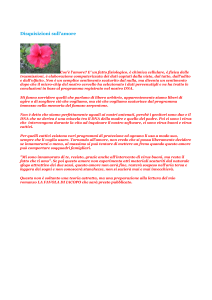
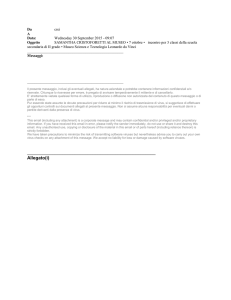

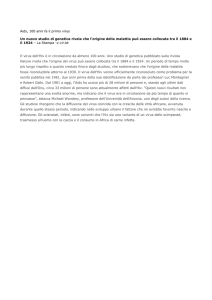
![Lezione 15 Virus [modalità compatibilità]](http://s1.studylibit.com/store/data/000771737_1-84b1cca561c5813066d1b76125338a98-300x300.png)
